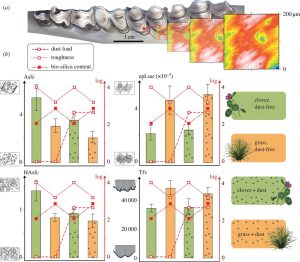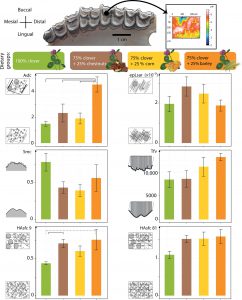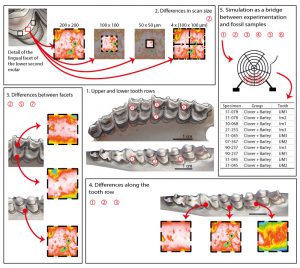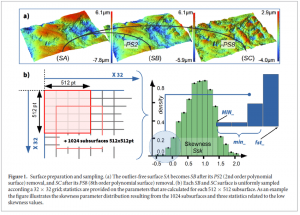Food tests: Sheep
Ewes are an ideal model for studying ruminant diets. Generally speaking, ruminants are the most abundant primary consumers in many Neogene and Quaternary deposits. Thus, their feeding habits, once reconstructed, will provide information on the composition of past vegetation.
Feeding trials on ewes were carried out as part of the ANR TriDent project, on an experimental farm under the supervision of the Centre Interrégional d’Information et de Recherche en Production Ovine (CIIRPO) and the Institut de l’Élevage.
The ewes were divided into groups, each corresponding to a different diet (grass, clover alone or with chestnuts, barley, corn, etc.).
The aim was to test the effects of diet on the state of dental abrasion after several weeks.

Several hypotheses have been tested (see below):
Hypothesis 1: Can dust mask the diet signal carried by the dental microwear?
_ Protocol: A sample of 40 ewes divided into four groups fed with different diets: grass or clover with or without “dust” (micrometric sedimentary particles).
_ Results: The presence of “dust” is unnecessary to generate differences in dental abrasion – the diet is enough!
_ For more information:
https://royalsocietypublishing.org/doi/full/10.1098/rspb.2016.1032


Hypothesis 2: Which seed parameters control dental abrasion?
_ Protocol: Sample of 40 ewes divided into four groups fed different diets: 100% clover, 75% clover and 25% chestnut, 75% clover and 25% maize or 75% clover and 25% barley.
_ Results: There was a significant difference between ewes fed barley and clover. Texture parameters do not appear to be correlated with seed hardness.
_ For further information:
https://onlinelibrary.wiley.com/doi/full/10.1002/ece3.2241
Hypothesis 3: Do all teeth and wear facets provide the same signal?
_ Protocol: A sample of 30 ewes divided into three groups, each fed a different diet: 100% clover, 75% clover and 25% barley or 100% grass. For each specimen, the upper and lower molars were scanned.
_ Results: There’s no need to artificially augment our fossil samples by integrating different facets or teeth. Once grouped, their different functions can mask the different dietary categories.
_ For further information:
https://hal.archives-ouvertes.fr/hal-02101056/.


Hypothesis 4: Can textural analysis of dental microwear take us further?
_ Protocol: Sub-sampling analysis of dental surfaces from three groups representing three species with different diets (Alcelaphus buselaphus, Alces alces and Cephalophus silvicultor).
_ Results: Sub-sampling identified parameters for more effective discrimination.
_ For more information:
https://iopscience.iop.org/article/10.1088/2051-672X/aa9dd3/meta
Funded by


Partners and Collaborations








